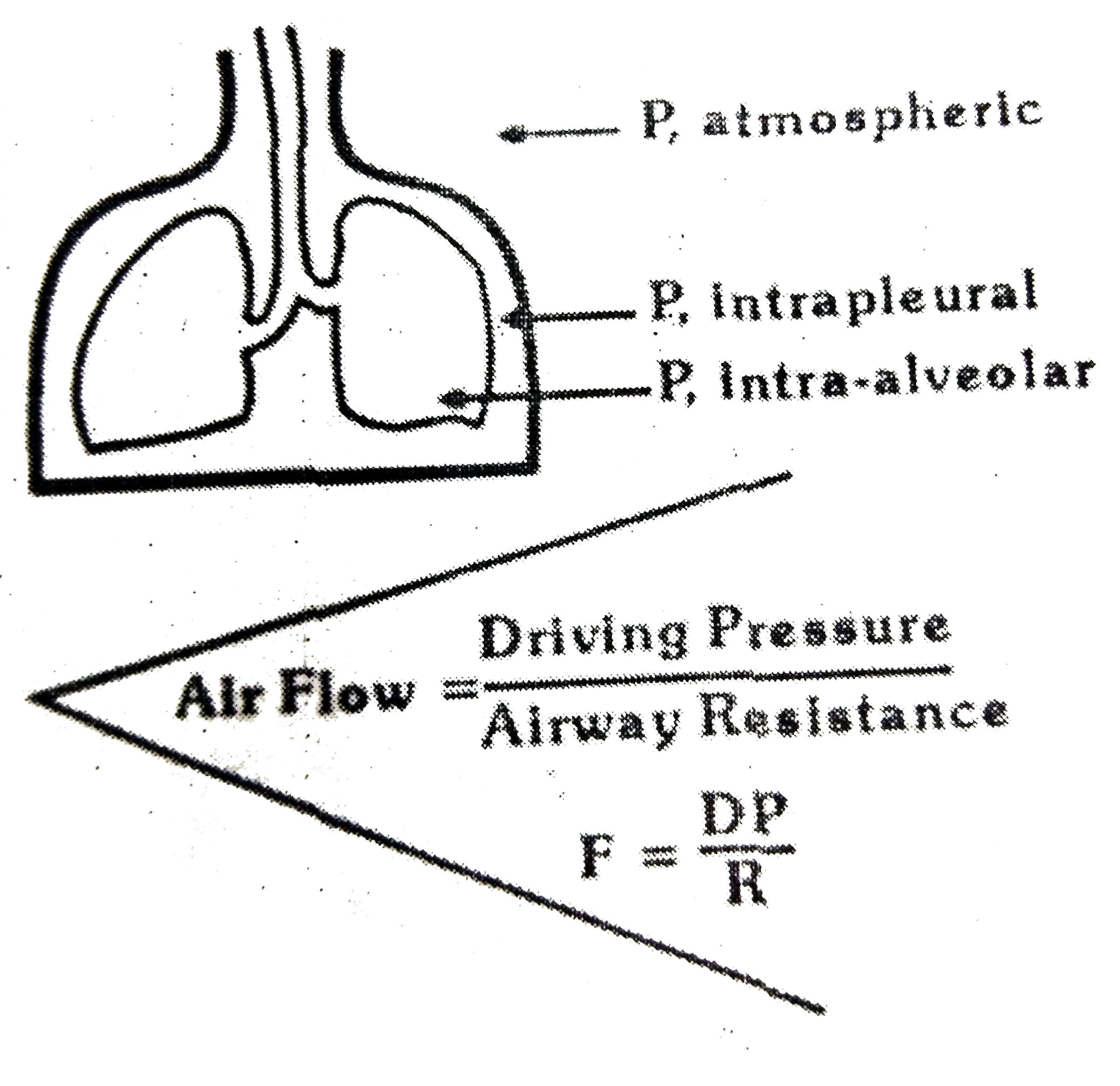Amount of air expelled from the lungs during the quiet breathing per one minute is
500 mL
6000-8000 mL
2,500 mL to 3000 mL
1000 - 1100 mL
The correct Answer is:B
To find the amount of air expelled from the lungs during quiet breathing per minute, we can follow these steps:
1. Understand Tidal Volume:
- Tidal volume is the amount of air that is inhaled or exhaled during normal, quiet breathing. It is typically around 500 ml per breath.
2. Determine Breathing Rate:
- The average breathing rate for a healthy adult at rest is approximately 12 to 14 breaths per minute.
3. Calculate Air Expelled in One Minute:
- To find the total amount of air expelled in one minute, multiply the tidal volume by the number of breaths taken per minute.
- Using the average values:
- For 12 breaths per minute:
Total air expelled=500ml/breath×12breaths/min=6000ml
- For 14 breaths per minute:
Total air expelled=500ml/breath×14breaths/min=7000ml
4. Determine the Range:
- Based on the calculations, the total amount of air expelled during quiet breathing in one minute ranges from 6000 ml to 8000 ml.
5. Select the Correct Option:
- Among the given options, the correct answer is 6000 to 8000 ml.
Final Answer:
The amount of air expelled from the lungs during quiet breathing per one minute is 6000 to 8000 ml.
---
- Tidal volume is the amount of air that is inhaled or exhaled during normal, quiet breathing. It is typically around 500 ml per breath.
- The average breathing rate for a healthy adult at rest is approximately 12 to 14 breaths per minute.
- To find the total amount of air expelled in one minute, multiply the tidal volume by the number of breaths taken per minute.
- Using the average values:
- For 12 breaths per minute:
Total air expelled=500ml/breath×12breaths/min=6000ml
- For 14 breaths per minute:
Total air expelled=500ml/breath×14breaths/min=7000ml
- Based on the calculations, the total amount of air expelled during quiet breathing in one minute ranges from 6000 ml to 8000 ml.
- Among the given options, the correct answer is 6000 to 8000 ml.
The amount of air expelled from the lungs during quiet breathing per one minute is 6000 to 8000 ml.
Topper's Solved these Questions
- BREATHING AND EXCHANGE OF GASES BOOK - AAKASH SERIESCHAPTER - BREATHING AND EXCHANGE OF GASES EXERCISE - EXERCISE-I (Exchange of Gases)
21 Videos
- BREATHING AND EXCHANGE OF GASES BOOK - AAKASH SERIESCHAPTER - BREATHING AND EXCHANGE OF GASES EXERCISE - EXERCISE-I (Transport of Gases)
31 Videos
- BREATHING AND EXCHANGE OF GASES BOOK - AAKASH SERIESCHAPTER - BREATHING AND EXCHANGE OF GASES EXERCISE - EXERCISE-III (Previous AIPMT/NEET Questions)
21 Videos
- BODY FLUIDS AND CIRCULATIONBOOK - AAKASH SERIESCHAPTER - BODY FLUIDS AND CIRCULATIONEXERCISE - Exercise -III (Previous AIPMT/NEET Questions)
35 Videos
- CHEMICAL COORDINATION AND INTERGRATIONBOOK - AAKASH SERIESCHAPTER - CHEMICAL COORDINATION AND INTERGRATIONEXERCISE - Exercise-III (previous AIPMT/NEET questions)
41 Videos
Similar Questions
Knowledge Check
The amount of air that enters lungs during normal respiration is :
Atidal volumeBvital capacityCtotal lung capacityDinspiratory capacity
Calculate the volume (in cm3) of air expelled from a vessel containing 0.4 litres of it at 250 K. when it is heated 27∘C at the same pressure.
View SolutionVolume of air breathed in and out during normal breathing is called
View SolutionVolume of air breathed in and out during normal breathing is called
View Solution
The alveolar ventilation per minute refers to the amount of fresh air which reaches the alveoli of the lungs per minute. Alvelor ventilation per minute equals the
View SolutionA: Normal expiration during quiet breathing, unlike
inspiration, is a passive process because on
muscular contractions are involved.
R: Normal expiration results from the elastic recoil
of the chest wall and lungs.
View SolutionComplete the following paragraph by filling in the blanks (i) to (x) with appropriate words:
The air breathed in and out in course of quiet breathing is termed as (i) .............. Some tidal air is left in (ii) .................. such as trachea and bronchi where no (iii) .............. of gases can occur. (iv) ............... is the air that can be drawn forcibly and (v).. ....... is the air forcibly expelled. The volume of air that can be taken (vi) ........... and (vii) ................. by maximum inspiration and expiration is called (viii) .............. . Some (ix) ..... air is always left in the (x)............. even after forcibly breathing out.
View SolutionA flask containing 250 mg of air at 27∘C is heated till 25.5% of air by mass is expelled from it. What is the final temperature of the flask ?
View Solution
